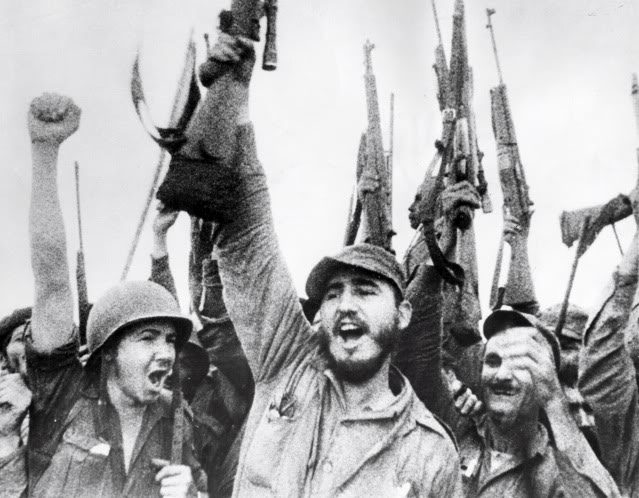
[Editor: DRGO presents this excerpt from a series by Dr. Faria in Hacienda Publishing, 2012, to illustrate the tyranny that firearm registration invites. In this case, in Cuba, as appropriate recognition of the long overdue death of Fidel Castro November 24.]
DATELINE: Havana, Cuba, 1959
And here is a story with which I am intimately familiar. After the triumph of the revolution in 1959, Fidel Castro reneged on his promise to establish democracy in Cuba. In response, the Revolutionary Directorate (RD), the opposing, non-communist group, threatened to renew the insurrection against the Castro brothers’ revolutionary government. To back their demands with substance or perhaps even expecting a showdown, the RD seized arms from the San Antonio de los Baños Air Force Base in the western part of the island.
Fidel Castro reacted characteristically in a speech at the Maestre Barracks of San Ambrosio, artfully commanding the situation by accusing the RD of seizing the arms and then, in a masterpiece of rhetoric, asking: Armas ¿para que? ¿Para luchar contra quién? ¿Contra el gobierno revolucionario, que tiene el apoyo del pueblo? (“Guns, for what? To fight against whom? Against the Revolutionary government that has the support of the people?”)
Fidel Castro defused the situation and neutralized the defiance of the RD. Shortly thereafter, Castro commenced his long-term campaign to disarm not only his confreres in the Revolutionary Directorate who had not joined him, but also, in due time, all Cubans. A 100,000-member “militia” was organized to seek out the political opposition and actively disarm it.
Unfortunately, they had a well-drawn blueprint to follow — the local firearm registration lists that the former dictator, Fulgencio Batista, had established. All the milicianos had to do was to seize the registration (licensing) lists and then go door to door searching for and confiscating firearms. The militia tried to disarm my father, a physician, and the episode is recounted in my book Cuba in Revolution — Escape from a Lost Paradise (2002). (5)
During the Batista dictatorship (1953-1958), Cubans were free to leave the country with family, personal possessions, and their wealth, anytime they wished, but not so in communist Cuba.
Since Fidel Castro took over the island in 1959, the best figures we can glean are that between 30,000 and 40,000 Cubans were either executed en los paredones de fusilamiento (on the firing squad wall) or died at the hands of their communist jailers. Between 1960-1965, hundreds of anti-communist rebels, many of them former RD members, went back to the hills of the Escambray Mountains in my native Las Villas province to fight the new communist  dictatorship of the Castro brothers. [Figure 4] The mostly peasant insurgents, who were defending their lands, lacked sufficient weapons to overcome the well-armed, communist Cuban military forces. Thus, most of these peasant insurgents were annihilated by 1966.(4–6)
dictatorship of the Castro brothers. [Figure 4] The mostly peasant insurgents, who were defending their lands, lacked sufficient weapons to overcome the well-armed, communist Cuban military forces. Thus, most of these peasant insurgents were annihilated by 1966.(4–6)
Moreover, between 1960 and 1993, 36,000 Cubans perished at sea trying to escape the Castro brothers’ communist inferno. If we include all of those who died escaping the regime, those who were shot or died in custody, the figure well exceeds 100,000. In fact, the late scholar Armando Lago arrived at a death toll of 105,000 victims directly attributed to the regime of Fidel Castro.(4,5)
Countless thousands of other Cubans have died indirectly as a result of Fidel Castro’s collectivist policies, unspeakable privations, malnutrition, and the general desolation of a once prosperous island — the island Christopher Columbus called the “Pearl of the Antilles.”
Lessons to be learned
One day, as it happened in the Soviet Union, we will learn the truth, and more accurate numbers will be available, recording the full extent of the brutality and destruction wrought by communism in Cuba. One reason this happened and Cuba today remains a totalitarian state despite the collapse of Soviet communism is because the Cuban people were disarmed.(4–6)
+ + + + + + + + + + + + + + + + + +
Before a standing army can rule, the people must be disarmed; as they are in almost every kingdom of Europe. The supreme power in America cannot enforce unjust laws by the sword; because the whole body of the people are armed, and constitute a force superior to any band of regular troops that can be, on any pretence [sic], raised in the United States.
— Noah Webster, An Examination of the Leading Principles of the Federal Constitution, 1787
+ + + + + + + + + + + + + + + + + +
— Miguel A. Faria, Jr., M.D. is a retired Clinical Professor of Neurosurgery and Adjunct Professor of Medical History at Mercer University School of Medicine. He is Associate Editor in Chief and World Affairs Editor of Surgical Neurology International. He served on the CDC’s Injury Research Grant Review Committee.
All DRGO articles by Miguel A. Faria, Jr., M.D.
Footnotes:
4. Faria MA Jr. Cuba in Revolution — Escape From a Lost Paradise. Macon, GA, Hacienda Publishing, 2002. http://www.haciendapub.com/articles/interview-dr-miguel-faria-part-i-myl….
5. Clark J. Cuba, Mito y Realidad — Testimonios de un Pueblo. Saeta Ediciones, 2nd edition, 1992.
6. Encinosa E. Cuba en Guerra — Historia de la Oposicion Anti‑Castrista 1959‑1993. Miami, FL, The Endowment for Cuban American Studies, 1994.

